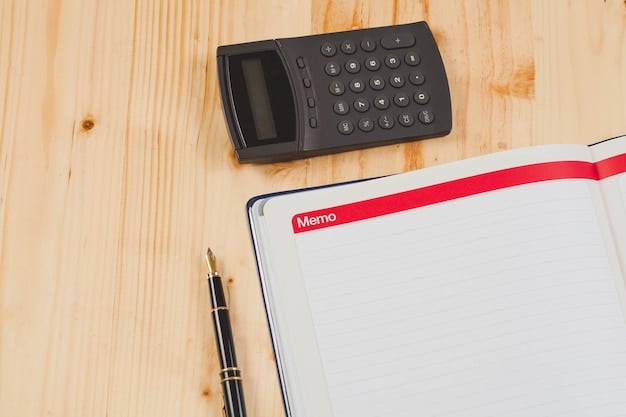Tax Planning for Self-Employed: Reduce Your Tax Burden by 15%

Tax planning for self-employed individuals is crucial for reducing the tax burden, involving strategies such as deducting business expenses, maximizing retirement contributions, and taking advantage of available credits to potentially lower tax liabilities by 15% or more.
Being self-employed offers numerous freedoms, but it also comes with the responsibility of managing your own taxes. Effective tax planning for self-employed individuals: reduce your tax burden by 15% may seems daunting, but with smart strategies, you can significantly lower your tax bill and keep more of your hard-earned money.
Understanding Self-Employment Taxes
Self-employment tax can often come as a surprise to those new to working for themselves. It’s essential to grasp the basics of these taxes to plan effectively.
Unlike traditional employees, self-employed individuals are responsible for paying both the employer and employee portions of Social Security and Medicare taxes. This combined tax is often referred to as self-employment tax.
What Makes Up Self-Employment Tax?
Self-employment tax consists of two parts: Social Security and Medicare. The Social Security portion is capped at a certain income level each year, while the Medicare portion is not. Understanding these components is crucial for accurate tax planning.
Calculating Your Self-Employment Tax
To calculate your self-employment tax, you’ll need to determine your net earnings subject to self-employment tax. This involves subtracting your business expenses from your business income. The resulting figure is then multiplied by the self-employment tax rate.
- Keep detailed records of all income and expenses.
- Understand the current self-employment tax rates and thresholds.
- Use tax preparation software or consult a tax professional to ensure accuracy.

Understanding the ins and outs of self-employment taxes is the first step towards effective tax planning. By knowing what you owe, you can begin to develop strategies to minimize your tax liability.
Deducting Business Expenses
One of the most effective ways to reduce your tax burden as a self-employed individual is by deducting legitimate business expenses. Knowing what you can deduct is key to lowering your taxable income.
Business expenses are generally defined as the ordinary and necessary costs of running your business. These can range from office supplies to vehicle expenses, and deducting them can significantly reduce your tax liability.
Common Business Expense Deductions
There are numerous business expenses that self-employed individuals can deduct, including expenses for office supplies, home office, vehicle use, and professional development. Keeping thorough records and understanding the rules for each type of deduction is essential.
Home Office Deduction
If you use a portion of your home exclusively and regularly for your business, you may be eligible for the home office deduction. This deduction can cover both direct and indirect expenses related to your home office space.
- Ensure that the area is used exclusively for business.
- Calculate the percentage of your home used for business.
- Keep records of mortgage interest, rent, utilities, and insurance.
Effectively deducting your business expenses can have a significant impact on your tax bill. Make sure you’re taking advantage of all eligible deductions to minimize your tax liability.
Maximizing Retirement Contributions
Contributing to retirement accounts not only secures your financial future but also provides significant tax benefits in the present. Self-employed individuals have several retirement plan options available to them.
Retirement contributions are often tax-deductible, meaning they can reduce your taxable income in the year you make the contribution. This can lead to substantial tax savings, especially for self-employed individuals.
SEP IRA
A Simplified Employee Pension (SEP) IRA is a popular retirement plan for the self-employed. It allows you to contribute a significant portion of your net self-employment income, and contributions are tax-deductible.
Solo 401(k)
A Solo 401(k) plan allows you to contribute both as an employee and as an employer, providing even greater potential for tax-deferred savings. This plan can be either traditional or Roth.
- Consider your current income and future retirement needs.
- Choose a plan that offers the best combination of contribution limits and tax benefits.
- Consult a financial advisor to determine the most suitable retirement plan for your situation.
Maximizing your retirement contributions is a win-win situation: you save for the future while reducing your tax burden today. Explore your options and choose the plan that best fits your financial goals.
Taking Advantage of Tax Credits
Tax credits can provide a dollar-for-dollar reduction of your tax liability, making them a valuable tool for self-employed individuals looking to lower their tax bill.
Unlike tax deductions, which reduce your taxable income, tax credits directly reduce the amount of tax you owe. This can result in significant tax savings, especially if you qualify for multiple credits.
Earned Income Tax Credit (EITC)
The Earned Income Tax Credit (EITC) is a credit for low- to moderate-income workers and families. Self-employed individuals may be eligible for the EITC, depending on their income and other factors.
Child Tax Credit
If you have qualifying children, you may be eligible for the Child Tax Credit. This credit can provide a significant reduction in your tax liability, helping you keep more of your income.

- Research available tax credits relevant to your situation.
- Determine your eligibility for each credit based on income and other criteria.
- Keep accurate records and documentation to support your credit claims.
Taking advantage of available tax credits can significantly reduce your tax burden. Explore the credits you may be eligible for and claim them when you file your taxes.
Health Insurance Deductions
Health insurance can be a significant expense for self-employed individuals. The good news is that you may be able to deduct the cost of your health insurance premiums, further reducing your tax liability.
Self-employed individuals can generally deduct the amount they paid in health insurance premiums for themselves, their spouse, and their dependents. This deduction can significantly lower your taxable income, especially if you have high health insurance costs.
Eligibility Requirements for the Health Insurance Deduction
To be eligible for the self-employed health insurance deduction, you must meet certain requirements. You cannot be eligible to participate in an employer-sponsored health plan, either through your own employer (if you have one) or your spouse’s employer.
Calculating the Deduction
The deduction is limited to the amount of your net self-employment income. In other words, you cannot deduct more in health insurance premiums than the amount you earned from your business. Additionally, the deduction cannot be used to reduce your self-employment tax.
- Keep detailed records of your health insurance premiums.
- Ensure that you meet the eligibility requirements for the deduction.
- Consult with a tax professional to ensure accurate calculation and deduction.
The self-employed health insurance deduction can provide substantial tax savings, helping you manage the cost of health insurance while reducing your tax burden. Make sure you’re taking advantage of this valuable deduction.
Record Keeping and Documentation
Accurate record keeping is essential for effective tax planning and compliance. Keeping detailed records of your income, expenses, and other tax-related information will help you minimize your tax liability and avoid potential issues with the IRS.
Proper documentation is crucial for substantiating your deductions and credits. Without adequate records, you may not be able to claim certain deductions or credits, resulting in a higher tax bill.
Best Practices for Record Keeping
There are several best practices you can follow to ensure accurate and organized record keeping. These include maintaining separate bank accounts for business and personal expenses, using accounting software, and regularly reconciling your records.
Types of Records to Keep
You should keep records of all income received, including invoices, sales receipts, and bank statements. You should also keep records of all business expenses, including receipts, bills, and canceled checks.
- Use a system for organizing your records, such as folders or digital files.
- Keep both physical and digital copies of important documents.
- Back up your digital records regularly to prevent data loss.
Staying organized and maintaining accurate records is key to stress-free tax preparation and effective tax planning. Your documentation ensures that you can take advantage of eligible deductions and credits.
| Key Point | Brief Description |
|---|---|
| 💰 Self-Employment Taxes | Understand Social Security and Medicare responsibilities. |
| 💼 Business Expenses | Deduct eligible costs like office supplies and home office. |
| 🏦 Retirement Contributions | Maximize SEP IRA or Solo 401(k) contributions for tax savings. |
| ⚕️ Health Insurance | Deduct health insurance premiums if eligible. |
Frequently Asked Questions (FAQ)
▼
The self-employment tax rate is 15.3%, which includes 12.4% for Social Security (up to a certain income limit) and 2.9% for Medicare. This rate applies to 92.35% of your self-employment income.
▼
Yes, you can deduct expenses for the portion of your home used exclusively and regularly for business. This includes rent, mortgage interest, utilities, and depreciation.
▼
Self-employed individuals can use SEP IRAs, Solo 401(k)s, and SIMPLE IRAs. Each plan has different contribution limits and requirements, so choose the best fit.
▼
A tax credit reduces your tax liability dollar-for-dollar, while a tax deduction reduces your taxable income. Tax credits typically offer a greater tax savings.
▼
Keep records of income (invoices, receipts) and expenses (bills, receipts, canceled checks). Organize these meticulously, possibly digitally, to easily reference and justify deductions.
Conclusion
Effective tax planning for self-employed individuals: reduce your tax burden by 15% is a continuous effort that requires careful attention to detail and a proactive approach. By understanding self-employment taxes, deducting business expenses, maximizing retirement contributions, taking advantage of tax credits, and maintaining accurate records, you can significantly reduce your tax liability and improve your financial well-being.





